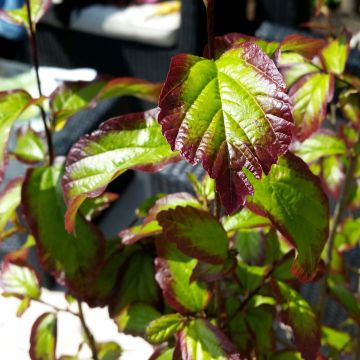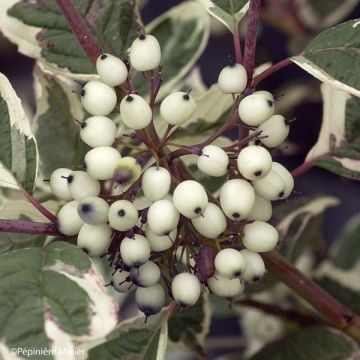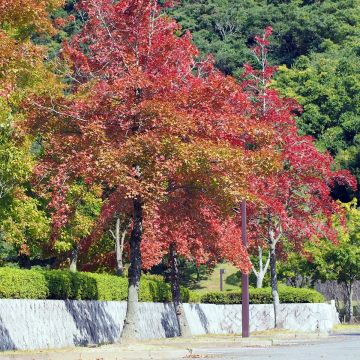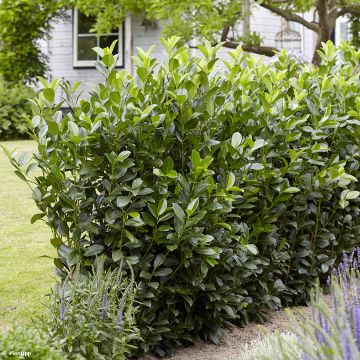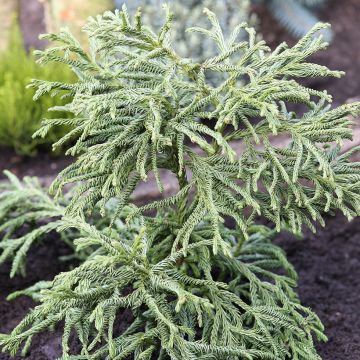

Parrotia persica Burgundy - Persian ironwood
Parrotia persica Burgundy - Persian ironwood
Parrotia persica Burgundy
Persian ironwood, Iron tree.
Beautiful tree, there is a magnificent specimen at the Jardin des Plantes in Paris. I used to go regularly to greet it in spring and autumn, splendid.
Francis, 11/01/2025
This item cannot be shipped to the selected country
Delivery charge from €6.90
More information
Delivery charge from €6.90
More information
Schedule delivery date,
and select date in basket
This plant carries a 24 months recovery warranty
More information
We guarantee the quality of our plants for a full growing cycle, and will replace at our expense any plant that fails to recover under normal climatic and planting conditions.
From €7.90 for pickup delivery and €6.90 for home delivery
Express home delivery from €8.90.
Does this plant fit my garden?
Set up your Plantfit profile →
Description
Parrotia persica 'Burgundy' is a variety of Persian Ironwood that stands out from the species due to its young spring foliage with a purple-violet colour and its uniform burgundy autumn colouring. This deciduous small tree also has a curious flowering with dark red stamen clusters that appear directly on the bare branches in early spring. In winter, its bark can be observed peeling off in plates, similar to plane trees.
The Persian Ironwood, in Latin Parrotia persica, belongs to the family Hamamelidaceae. It is native to northern Iran and eastern Caucasus.
Parrotia persica 'Burgundy' reaches approximately 8m in height and 3m in spread at the age of 10-12 years, depending on growing conditions. It has a stout trunk, sometimes even multiple small trunks, with grey bark that peels off in a beautiful camouflage pattern over time. The flowers appear before the leaves, directly on the branches. They consist of reddish-purple stamen surrounded by brown bracts. This 'Burgundy' variety develops young shoots with a purple-violet colour in spring. The shiny leaves develop a purple margin on a green background. Then the leaves turn burgundy before falling. The leaves, with wavy edges and more or less diamond-shaped, are thick, strongly veined, and resemble those of beech trees. In winter, the bark of this small tree peels off in plates and reveals subtle shades of gray, reddish-brown, and greenish-grey. The colours will be more pronounced in acidic soil, although this tree tolerates limestone.
Parrotia persica 'Burgundy' can be planted individually in a medium-sized garden, in a grove, a large hedge, or in alignment in a park. For example, associate it with Witch Hazels and Nyssas in acidic soil. In neutral or slightly alkaline, well-drained soil, pair it with the Smoke Bush 'Grace', the Dwarf Winged Spindle Tree (Euonymus alatus 'Fireball'), and tall autumn asters to create a vibrant grove from September to November. It should be noted that the Persian Ironwood's drought resistance and hardiness allow it to be cultivated in many situations.
Parrotia persica was introduced to Europe in 1841. Its common name, Ironwood, is inspired by its exceptionally hard and difficult-to-work wood. It has been used as the basis for tools that are sometimes over 2000 years old.
Plant habit
Flowering
Foliage
Botanical data
Parrotia
persica
Burgundy
Hamamelidaceae
Persian ironwood, Iron tree.
Cultivar or hybrid
Other Parrotia - Persian Ironwood
View all →Planting and care
Plant the 'Burgundy' Iron Tree preferably in acidic to neutral soil, moist to dry in summer, but always well-drained. Limestone is well tolerated. The origins of this large bush explain its undemanding nature (in Iran, the climate is hot and dry). It will thrive in partial shade or full sun, but it is commonly accepted that the autumn shades of the canopy will be more intense in soil with an acidic and moist tendency and with a sunny, but not scorching, exposure. The main enemies of the Persian Ironwood are moles.
Planting period
Intended location
Care
Planting & care advice
-
, onOrder confirmed
Reply from on Promesse de fleurs
Striking foliage shrubs
Haven't found what you were looking for?
Hardiness is the lowest winter temperature a plant can endure without suffering serious damage or even dying. However, hardiness is affected by location (a sheltered area, such as a patio), protection (winter cover) and soil type (hardiness is improved by well-drained soil).

Photo Sharing Terms & Conditions
In order to encourage gardeners to interact and share their experiences, Promesse de fleurs offers various media enabling content to be uploaded onto its Site - in particular via the ‘Photo sharing’ module.
The User agrees to refrain from:
- Posting any content that is illegal, prejudicial, insulting, racist, inciteful to hatred, revisionist, contrary to public decency, that infringes on privacy or on the privacy rights of third parties, in particular the publicity rights of persons and goods, intellectual property rights, or the right to privacy.
- Submitting content on behalf of a third party;
- Impersonate the identity of a third party and/or publish any personal information about a third party;
In general, the User undertakes to refrain from any unethical behaviour.
All Content (in particular text, comments, files, images, photos, videos, creative works, etc.), which may be subject to property or intellectual property rights, image or other private rights, shall remain the property of the User, subject to the limited rights granted by the terms of the licence granted by Promesse de fleurs as stated below. Users are at liberty to publish or not to publish such Content on the Site, notably via the ‘Photo Sharing’ facility, and accept that this Content shall be made public and freely accessible, notably on the Internet.
Users further acknowledge, undertake to have ,and guarantee that they hold all necessary rights and permissions to publish such material on the Site, in particular with regard to the legislation in force pertaining to any privacy, property, intellectual property, image, or contractual rights, or rights of any other nature. By publishing such Content on the Site, Users acknowledge accepting full liability as publishers of the Content within the meaning of the law, and grant Promesse de fleurs, free of charge, an inclusive, worldwide licence for the said Content for the entire duration of its publication, including all reproduction, representation, up/downloading, displaying, performing, transmission, and storage rights.
Users also grant permission for their name to be linked to the Content and accept that this link may not always be made available.
By engaging in posting material, Users consent to their Content becoming automatically accessible on the Internet, in particular on other sites and/or blogs and/or web pages of the Promesse de fleurs site, including in particular social pages and the Promesse de fleurs catalogue.
Users may secure the removal of entrusted content free of charge by issuing a simple request via our contact form.


































